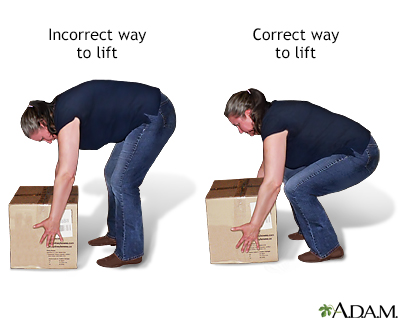Proper lifting technique

You can injure your back lifting heavy objects the wrong way. To prevent injuries, warm up or stretch your muscles before you lift heavy objects. Know your limits, and don’t try to lift objects that are too heavy. When lifting, spread your feet apart, around the width of your shoulders, to give your body a wide base of support. Stand as close as possible to the object you are lifting and bend at your knees. Tighten your stomach muscles and slowly lift the object using your hip and knee muscles. Hold the object as close to your body as you can. Do not twist your back when you bend to reach or lift the object. To set the object down, squat with a straight back, using the muscles in your hips and knees. Remember, the better conditioned you are the less likely you will be to injure yourself.

|
Review Date:
10/9/2024 Reviewed By: Linda J. Vorvick, MD, Clinical Professor, Department of Family Medicine, UW Medicine, School of Medicine, University of Washington, Seattle, WA. Also reviewed by David C. Dugdale, MD, Medical Director, Brenda Conaway, Editorial Director, and the A.D.A.M. Editorial team. |
